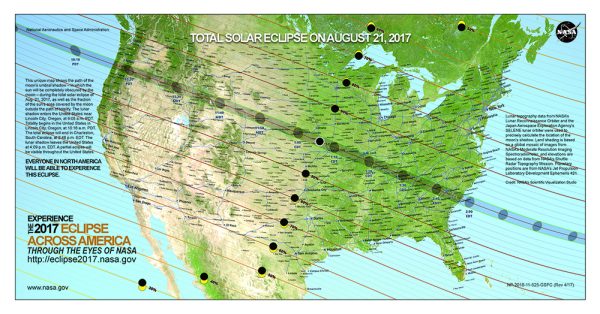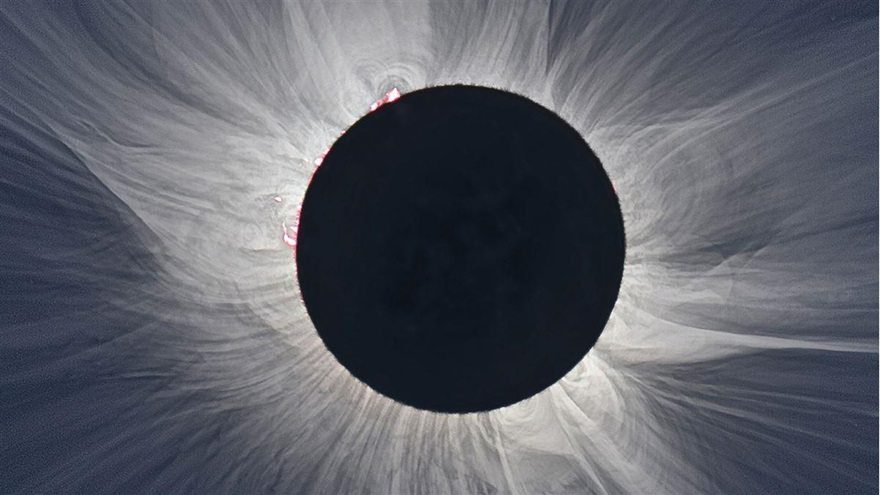Observatory Director Brings Historic Solar Eclipse Into Focus

By now you’ve probably heard that a total solar eclipse is coming to North American skies on Monday, Aug. 21, 2017, and the Carolinas have a front row seat. UNC Charlotte Observatory director and astrophysicist Catherine Qualtrough of the College of Liberal Arts & Sciences shares the basics of this historic event.
What is a solar eclipse?
A solar eclipse occurs when the moon passes between Earth and the sun, blocking out all (total eclipse) or part (partial eclipse) of the sun’s light. In a quirk of celestial geometry, even though the moon is 400 times smaller than the sun it is 400 times closer to Earth. This lucky fact means the two bodies appear almost the same size in the sky. So, when the alignment is just right the moon can completely cover the disc of the sun, and for those in the path of the moon’s shadow, the sun will go dark.
How often does this happen?
The moon orbits the Earth once a month, but total solar eclipses are actually much rarer because the moon doesn’t orbit in the same plane as the Earth and sun. On average, a total eclipse is visible somewhere on Earth about every 18 months, but for any one location there may be hundreds of years in between. The August eclipse will be the first total solar eclipse visible across the entire United States in 99 years, and we won’t see another on U.S. soil until 2024. For North Carolina, we’ll wait until 2078 for the next total eclipse.
What is the “path of totality?”
While everyone in the continental United States will see at least a partial eclipse on Aug. 21, the best experience will be in the “path of totality,” a 70-mile-wide ribbon of land lying under the moon’s darkest shadow (the “umbra”). Charlotte itself will experience a 98 percent partial view of the eclipse starting at 1:05 p.m. and ending around 4 p.m. with a peak at 2:41 p.m.
What will I see?
 Veteran “eclipse-chasers” describe a moving and jaw-dropping experience during totality – the almost 2 minute 30 second period in which the moon completely covers the sun in the sky. Viewers can expect a sky as dark as night with planets and stars popping into view, temperatures dropping as much as 10-15 degrees Fahrenheit and a rare and magical view of the sun’s wispy outer layer, the corona, dancing outside the inky black outline of the moon.
Veteran “eclipse-chasers” describe a moving and jaw-dropping experience during totality – the almost 2 minute 30 second period in which the moon completely covers the sun in the sky. Viewers can expect a sky as dark as night with planets and stars popping into view, temperatures dropping as much as 10-15 degrees Fahrenheit and a rare and magical view of the sun’s wispy outer layer, the corona, dancing outside the inky black outline of the moon.
Although the view in Charlotte will be less dramatic, it is still not to be missed. Expect it to feel like an eerie dusk in the afternoon with bright Venus and Jupiter visible at the peak.
This eclipse simulator shows you what the eclipse will look like near your location.
How can I view the eclipse safely?
Your parents may have warned you never to look directly at the sun, and they were right (again). The good news is you don’t need a telescope or fancy equipment to be safe. Eclipse glasses, which are available online and at local retailers like Lowe’s, offer a safe, filtered view. While it is safe to remove your eclipse glasses during the brief period of totality during a full eclipse, glasses should never be removed during a partial eclipse (like in Charlotte). For more important eye safety information, visit the NASA eclipse website.
Travel problems
While it’s tempting to think of driving to the path of totality, experts warn of traffic gridlock. With 1 million visitors expected in Columbia, South Carolina alone and accommodations booked out for months, last-minute trips are not recommended.
Happy Viewing!
For most, a total eclipse is a once in a lifetime experience. And sadly, for our distant descendants, as the moon is drifting slowly away from the Earth (at the rate of 1.5 inches a year) these events won’t happen forever. In about 600 million years, Earth will experience the drama of a total solar eclipse for the very last time.
For more information on eclipse viewing tips and future astronomical events, contact Catherine Qualtrough at the UNC Charlotte Observatory. Hear more on this WCNC report.
Pictured: NASA map showing the eclipse path. Second image: the sun’s corona, helmet streamers, prominences, polar flumes, and coronal loops can be seen in this total solar eclipse photo. Photo courtesy of S. Habbal, M. Druckmuller, and P. Aniol, NASA.